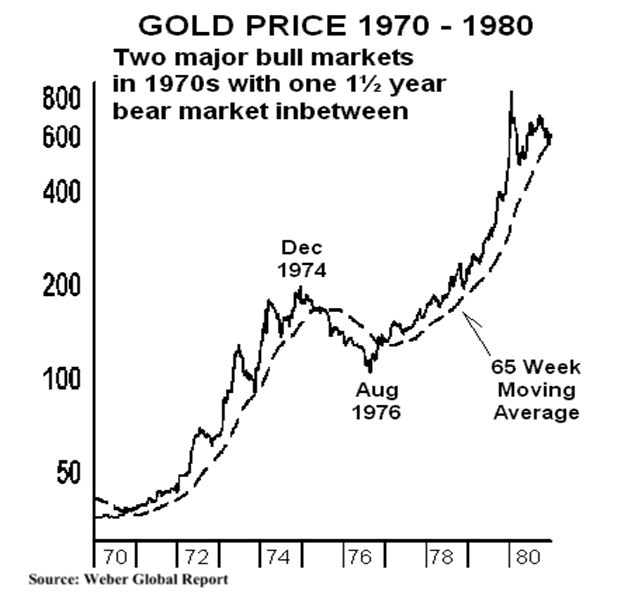Gold Price Set to Double This Fall
Commodities / Gold & Silver 2009 May 21, 2009 - 04:08 AM GMTBy: Paul_Learton
 Gold was, is, and always will be THE ultimate storehouse of value. Mankind was prizing this stuff during the prehistoric period, long before the concept of stocks, mutual funds, or paper money even existed.
Gold was, is, and always will be THE ultimate storehouse of value. Mankind was prizing this stuff during the prehistoric period, long before the concept of stocks, mutual funds, or paper money even existed.
Now, I know what you’re thinking, “gold has already risen from $250 to $900 an ounce, how much higher can it go?”
Much, MUCH higher, my friends.
No investment ever goes straight up or straight down. During the last bull market in gold, the precious metal rose 2,329% from a low of $35 in 1970 to a high of $850 in 1980. However, during that time, there was a period of 18 months in which gold fell nearly 50% (see the chart below).

As you can see, from mid-1971 to December 1974, gold rose 471%. It then fell 50%, from December ’74 to August ’76. After that, it began its next leg up, exploding 750% higher from August ’76 to January 1980.
Now, in its current bull market (2001 to March 2008), gold rose over 300% from $250 to a little over $1,000. And just like in the mid-70s, it began showing signs of weakness after its first big rally up to $1,014 in March ’08. At one point, it even fell to $700, a 30% retraction. Granted, it wasn’t a full 50% retraction like the one that occurred from 1974-76. But we are experiencing a financial crisis. And gold is the most common catastrophe insurance.
If we were to go by the historic pattern of the gold market in the ‘70s, gold should experience upwards resistance for 19 months after its first peak today. Gold’s recent peak was $1,014 in March ’08 (roughly 14 months before the writing of this report). If this bull market parallels the last one, then gold should renew its upward momentum in a very serious way starting in October 2009. And this next leg up should be a major one (the biggest gains came during the second rally in gold’s bull market in the ‘70s).
However, judging from the Fed’s money printing, the next leg up may come even earlier.
Now, a lot of commentators have noted that gold is already trading above its 1980 high ($850 an ounce). What they fail to note is that thanks to inflation, $1 in the ‘70s is worth a LOT MORE than a $1 today.
| $1 in… | Is Worth Today |
| 1970 | $5.49 |
| 1980 | $2.58 |
For gold to hit a new all time high adjusted for inflation, it would have to clear at least $2,193 per ounce. If you go by 1970 dollars (when gold started its last bull market) it’d have to hit $4,666 per ounce.
Bottomline: gold is nowhere near a peak adjusted for inflation. And if history is any guide, we should begin another MAJOR bull rally for gold sometime in the late summer/ early autumn of this year.
You should consider taking advantage of this to load up now.
Good Investing!
By Paul Learton
PS. I’ve put together a FREE Special Report on a backdoor way into buying gold at $188 an ounce. To get your FREE copy go to www.gainspainscapital.com
Paul is Chief Investment Strategist for OmniSans Research, an independent financial research firm based in Charlottesville, VA.
Paul focuses exclusively on timing major trends between asset classes and financial markets. He's not looking for temporary bottoms or momentum plays, rather, he's looking for seismic shifts in capital flows and consumer behavior, measuring profits and market moves in terms of years if not decades. Paul's long-term horizon and voluminous knowledge of historic trends and economic data shape all of OmniSans Research's investment strategies.
Previously Paul worked as a wealth manager for several private clients.
© 2009 Copyright Paul Learton to - All Rights Reserved
Disclaimer: The above is a matter of opinion provided for general information purposes only and is not intended as investment advice. Information and analysis above are derived from sources and utilising methods believed to be reliable, but we cannot accept responsibility for any losses you may incur as a result of this analysis. Individuals should consult with their personal financial advisors.
© 2005-2022 http://www.MarketOracle.co.uk - The Market Oracle is a FREE Daily Financial Markets Analysis & Forecasting online publication.



